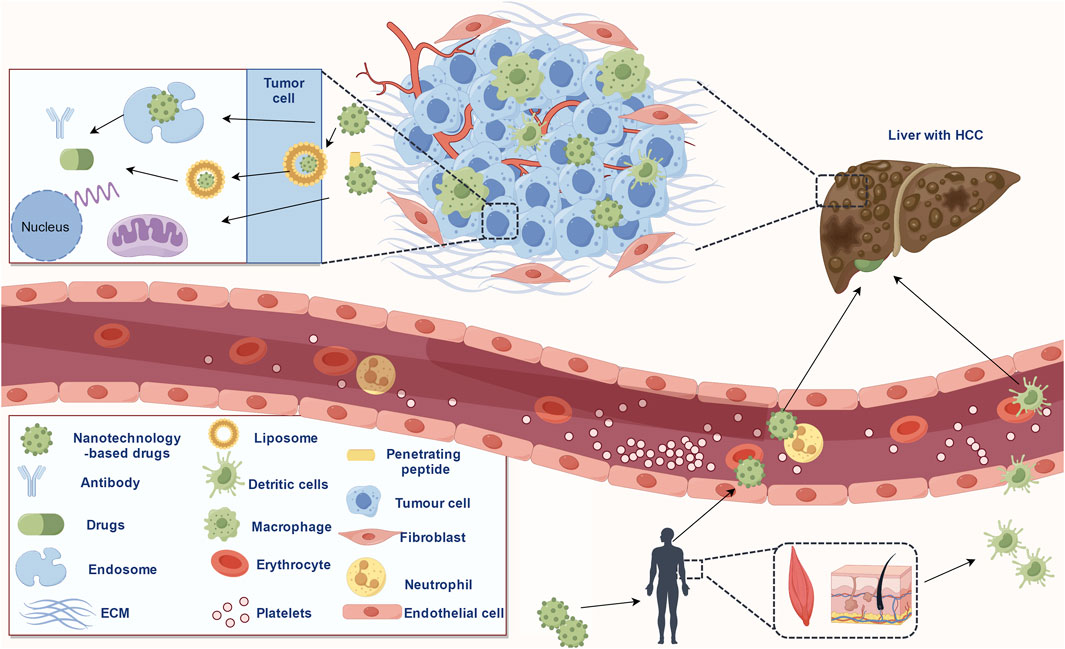Introduction
Nanomedicine, a cutting-edge field at the intersection of nanotechnology and medicine, harnesses the unique properties of nanoscale materials to improve diagnosis, treatment, and monitoring of diseases. By manipulating materials at the nanometer scale (one billionth of a meter), scientists can create highly precise and effective tools for managing liver diseases. This section delves into the various applications of nanomedicine in liver disease, highlighting its potential to revolutionize patient care and outcomes.
Core Concepts of Nanomedicine
- Nanoparticles:
- Definition: Nanoparticles are microscopic particles with dimensions ranging from 1 to 100 nanometers. Due to their size, they exhibit distinct physical and chemical properties compared to bulk materials.
- Types: Common types include liposomes, dendrimers, quantum dots, and gold nanoparticles.
- Nanoscale Drug Delivery:
- Overview: Nanoparticles can be engineered to deliver drugs directly to targeted liver cells or tissues, enhancing therapeutic efficacy while minimizing systemic side effects.
- Mechanisms: Nanoparticles can use various mechanisms for targeted delivery, including passive targeting (accumulating in diseased tissues due to leaky blood vessels) and active targeting (binding to specific receptors on target cells).
- Imaging and Diagnostics:
- Overview: Nanomedicine can improve imaging techniques by using nanoparticles as contrast agents in imaging modalities such as magnetic resonance imaging (MRI), computed tomography (CT), and ultrasound.
- Applications: Enhanced imaging provides better visualization of liver structures and abnormalities, aiding in early diagnosis and monitoring of liver diseases.
- Theranostics:
- Definition: Theranostics combines therapy and diagnostics in a single platform, allowing for simultaneous disease detection and treatment.
- Benefits: This approach enables personalized treatment by monitoring therapeutic responses and adjusting treatments in real-time.
Applications in Liver Disease
- Targeted Drug Delivery:
- Cancer Therapy: Nanoparticles can deliver chemotherapy drugs directly to liver tumors, reducing off-target effects and improving drug efficacy. For example, liposomal formulations of doxorubicin have shown promise in treating liver cancer with fewer side effects.
- Antiviral Drugs: Nanoparticles can enhance the delivery of antiviral drugs used to treat chronic hepatitis B and C, potentially improving treatment outcomes and adherence.
- Liver Imaging Enhancement:
- Contrast Agents: Quantum dots and superparamagnetic nanoparticles can be used as contrast agents in MRI and CT scans, providing detailed images of liver lesions and vascular structures.
- Ultrasound Imaging: Nanoparticles can enhance ultrasound imaging by improving contrast and resolution, allowing for more accurate assessment of liver conditions.
- Liver Regeneration and Repair:
- Stem Cell Delivery: Nanoparticles can be used to deliver stem cells or growth factors directly to damaged liver tissues, promoting regeneration and repair in conditions such as cirrhosis or acute liver failure.
- Bioengineering: Nanotechnology can aid in the development of bioengineered liver tissues or scaffolds for transplantation, providing alternatives to traditional organ transplants.
- Early Detection of Liver Diseases:
- Biosensors: Nanomedicine enables the development of highly sensitive biosensors for detecting biomarkers associated with liver diseases. These sensors can provide early warnings of conditions like liver cancer or hepatitis, allowing for timely intervention.
- Molecular Imaging: Techniques such as fluorescence imaging using nanoparticle probes can identify molecular changes in liver tissues, aiding in early diagnosis and personalized treatment planning.
- Prevention and Management:
- Vaccination: Nanoparticle-based vaccines could improve the efficacy and delivery of vaccines against viral hepatitis, offering better protection and long-term immunity.
- Drug Resistance: Nanomedicine can help overcome drug resistance by delivering high concentrations of medications to target cells, potentially addressing challenges in treating chronic liver infections.

Challenges and Future Directions
- Safety and Toxicity:
- Concerns: The long-term safety and potential toxicity of nanoparticles are critical concerns. Comprehensive studies are needed to assess the biocompatibility, biodistribution, and degradation of nanoparticles in the body.
- Regulations: Establishing rigorous guidelines and standards for nanoparticle use in medicine is essential to ensure patient safety.
- Manufacturing and Scalability:
- Challenges: Producing nanoparticles with consistent quality and in large quantities remains a challenge. Advances in manufacturing technologies are needed to scale up production for clinical use.
- Cost: The cost of developing and implementing nanomedicine technologies can be high, potentially limiting accessibility for some patients.
- Regulatory Approval:
- Process: Gaining regulatory approval for new nanomedicine-based treatments and diagnostics involves extensive clinical trials and rigorous evaluations. Collaboration between researchers, industry, and regulatory agencies is crucial for advancing these technologies.
- Integration with Existing Therapies:
- Combining Approaches: Integrating nanomedicine with existing treatments and standard care practices can enhance overall therapeutic strategies and improve patient outcomes.
Conclusion
Nanomedicine represents a revolutionary approach to diagnosing and treating liver diseases, offering targeted drug delivery, enhanced imaging, and innovative therapeutic strategies. As research and development in this field progress, the potential benefits of nanomedicine in liver disease management continue to expand. Addressing challenges related to safety, manufacturing, and regulatory approval will be essential for realizing the full potential of nanomedicine and improving patient care in liver diseases.







